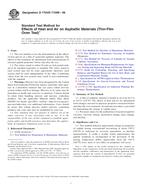We need your consent to use the individual data so that you can see information about your interests, among other things. Click "OK" to give your consent.
ASTM D1754/D1754M-09
Standard Test Method for Effect of Heat and Air on Asphaltic Materials (Thin-Film Oven Test)
STANDARD published on 1.7.2009
The information about the standard:
Designation standards: ASTM D1754/D1754M-09
Note: WITHDRAWN
Publication date standards: 1.7.2009
SKU: NS-18268
The number of pages: 6
Approximate weight : 18 g (0.04 lbs)
Country: American technical standard
Category: Technical standards ASTM
Annotation of standard text ASTM D1754/D1754M-09 :
Keywords:
aging, asphalt cement, Thin-Film Oven Test (TFOT), Asphalt paving mixtures, Film, Heat and air effects analysis, Ovens, Thin film oven test (TFOT), Thin material specimens/applications--concrete, ICS Number Code 91.100.50 (Binders. Sealing materials), 93.080.20 (Road construction materials)
Additional information
| Significance and Use | ||||||||||||||||||
|
This method indicates approximate change in properties of asphalt during conventional hot-mixing at about 150°C [302°F] as indicated by viscosity, penetration, or ductility measurements. It yields a residue which approximates the asphalt condition as incorporated in the pavement. If the mixing temperature differs appreciably from the 150°C [302°F] level, more or less effect on properties will occur. Note 1—The quality of the results produced by this standard are dependent on the competence of the personnel performing the procedure and the capability, calibration, and maintenance of the equipment used. Agencies that meet the criteria of Specification D 3666 are generally considered capable of competent and objective testing and sampling. |
||||||||||||||||||
| 1. Scope | ||||||||||||||||||
|
1.1 This test method covers the determination of the effects of heat and air on a film of semisolid asphaltic materials. The effects of this treatment are determined from measurements of selected asphalt properties before and after the test. 1.2 The values stated in either SI units or inch-pound units are to be regarded separately as standard. The values stated in each system may not be exact equivalents; therefore, each system shall be used independently of the other. Combining values from the two systems may result in non-conformance with the standard. 1.3 Warning—Mercury has been designated by the United States Environmental Protection Agency and many state agencies as a hazardous material that can cause central nervous system, kidney and liver damage. Mercury, or its vapor, may be hazardous to health and corrosive to materials. Caution should be taken when handling mercury and mercury containing products. See the applicable Material Safety Data Sheet (MSDS) for details and EPA’s website—http://www.epa.gov/mercury/index.htm—for additional information. Users should be aware that selling mercury and/or mercury containing products into your state may be prohibited by state law. 1.4 This standard does not purport to address all of the safety concerns, if any, associated with its use. It is the responsibility of the user of this standard to establish appropriate safety and health practices and determine the applicability of regulatory limitations prior to use. |
||||||||||||||||||
| 2. Referenced Documents | ||||||||||||||||||
|
We recommend:
Updating of laws
Do you want to be sure about the validity of used regulations?
We offer you a solution so that you could use valid and updated legislative regulations.
Would you like to get more information? Look at this page.




 Cookies
Cookies
